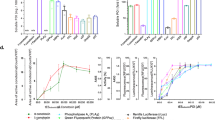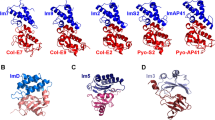Abstract
Many proteins reach their native state through pathways involving the presence of folding intermediates. It is not clear whether this type of folding landscape results from insufficient evolutionary pressure to optimize folding efficiency, or arises from a conflict between functional and folding constraints. Here, using protein-engineering, ultra-rapid mixing and stopped-flow experiments combined with restrained molecular dynamics simulations, we characterize the transition state for the formation of the intermediate populated during the folding of the bacterial immunity protein, Im7, and the subsequent molecular steps leading to the native state. The results provide a comprehensive view of the folding process of this small protein. An analysis of the contributions of native and non-native interactions at different stages of folding reveals how the complexity of the folding landscape arises from concomitant evolutionary pressures for function and folding efficiency.
This is a preview of subscription content, access via your institution
Access options
Subscribe to this journal
Receive 12 print issues and online access
$189.00 per year
only $15.75 per issue
Buy this article
- Purchase on Springer Link
- Instant access to full article PDF
Prices may be subject to local taxes which are calculated during checkout







Similar content being viewed by others
References
Roder, H., Maki, K. & Cheng, H. Early events in protein folding explored by rapid mixing methods. Chem. Rev. 106, 1836–1861 (2006).
Schuler, B. & Eaton, W.A. Protein folding studied by single-molecule FRET. Curr. Opin. Struct. Biol. 18, 16–26 (2008).
Dill, K.A. & Chan, H.S. From Levinthal to pathways to funnels. Nat. Struct. Biol. 4, 10–19 (1997).
Onuchic, J.N. & Wolynes, P.G. Theory of protein folding. Curr. Opin. Struct. Biol. 14, 70–75 (2004).
Bryngelson, J.D. & Wolynes, P.G. Spin glasses and the statistical mechanics of protein folding. Proc. Natl. Acad. Sci. USA 84, 7524–7528 (1987).
Hill, R.B. et al. De novo design of helical bundles as models for understanding protein folding and function. Acc. Chem. Res. 33, 745–754 (2000).
Sauer, R.T. Protein folding from a combinatorial perspective. Fold. Des. 1, R27–R30 (1996).
Watters, A.L. et al. The highly cooperative folding of small naturally occurring proteins is likely the result of natural selection. Cell 128, 613–624 (2007).
Monsellier, E. & Chiti, F. Prevention of amyloid-like aggregation as a driving force of protein evolution. EMBO Rep. 8, 737–742 (2007).
Mitraki, A. et al. Global suppression of protein folding defects and inclusion body formation. Science 253, 54–58 (1991).
Jahn, T.R. & Radford, S.E. Folding versus aggregation: polypeptide conformations on competing pathways. Arch. Biochem. Biophys. 469, 100–117 (2008).
Brockwell, D.J. & Radford, S.E. Intermediates: ubiquitous species on folding energy landscapes? Curr. Opin. Struct. Biol. 17, 30–37 (2007).
Dennis, C.A. et al. A structural comparison of the colicin immunity proteins Im7 and Im9 gives new insights into the molecular determinants of immunity-protein specificity. Biochem. J. 333, 183–191 (1998).
Capaldi, A.P., Kleanthous, C. & Radford, S.E. Im7 folding mechanism: misfolding on a path to the native state. Nat. Struct. Biol. 9, 209–216 (2002).
Capaldi, A.P. et al. Ultrarapid mixing experiments reveal that Im7 folds via an on-pathway intermediate. Nat. Struct. Biol. 8, 68–72 (2001).
Ferguson, N. et al. Rapid folding with and without populated intermediates in the homologous four-helix proteins Im7 and Im9. J. Mol. Biol. 286, 1597–1608 (1999).
Gorski, S.A. et al. Equilibrium hydrogen exchange reveals extensive hydrogen bonded secondary structure in the on-pathway intermediate of Im7. J. Mol. Biol. 337, 183–193 (2004).
Cranz-Mileva, S., Friel, C.T. & Radford, S.E. Helix stability and hydrophobicity in the folding mechanism of the bacterial immunity protein Im9. Protein Eng. Des. Sel. 18, 41–50 (2005).
Friel, C.T., Beddard, G.S. & Radford, S.E. Switching two-state to three-state kinetics in the helical protein Im9 via the optimisation of stabilising non-native interactions by design. J. Mol. Biol. 342, 261–273 (2004).
Li, W. et al. Highly discriminating protein-protein interaction specificities in the context of a conserved binding energy hotspot. J. Mol. Biol. 337, 743–759 (2004).
Goh, C.S. & Cohen, F.E. Co-evolutionary analysis reveals insights into protein-protein interactions. J. Mol. Biol. 324, 177–192 (2002).
Gsponer, J. et al. Determination of an ensemble of structures representing the intermediate state of the bacterial immunity protein Im7. Proc. Natl. Acad. Sci. USA 103, 99–104 (2006).
Whittaker, S.B. et al. NMR analysis of the conformational properties of the trapped on-pathway folding intermediate of the bacterial immunity protein Im7. J. Mol. Biol. 366, 1001–1015 (2007).
Fersht, A.R. Nucleation mechanisms in protein folding. Curr. Opin. Struct. Biol. 7, 3–9 (1997).
Vendruscolo, M. et al. Three key residues form a critical contact network in a protein folding transition state. Nature 409, 641–645 (2001).
Lindorff-Larsen, K. et al. Calculation of mutational free energy changes in transition states for protein folding. Biophys. J. 85, 1207–1214 (2003).
Salvatella, X. et al. Determination of the folding transition states of barnase by using PhiI-value-restrained simulations validated by double mutant PhiIJ-values. Proc. Natl. Acad. Sci. USA 102, 12389–12394 (2005).
Guerois, R., Nielsen, J.E. & Serrano, L. Predicting changes in the stability of proteins and protein complexes: a study of more than 1000 mutations. J. Mol. Biol. 320, 369–387 (2002).
Munoz, V. & Serrano, L. Development of the multiple sequence approximation within the AGADIR model of α-helix formation: comparison with Zimm-Bragg and Lifson-Roig formalisms. Biopolymers 41, 495–509 (1997).
Rodriguez-Mendieta, I.R. et al. Ultraviolet resonance Raman studies reveal the environment of tryptophan and tyrosine residues in the native and partially folded states of the E. colicin-binding immunity protein Im7. Biochemistry 44, 3306–3315 (2005).
Dobson, C.M. Protein folding and misfolding. Nature 426, 884–890 (2003).
Jemth, P. et al. The structure of the major transition state for folding of an FF domain from experiment and simulation. J. Mol. Biol. 350, 363–378 (2005).
Sutto, L. et al. Consequences of localized frustration for the folding mechanism of the Im7 protein. Proc. Natl. Acad. Sci. USA 104, 19825–19830 (2007).
Keeble, A.H. & Kleanthous, C. The kinetic basis for dual recognition in colicin endonuclease-immunity protein complexes. J. Mol. Biol. 352, 656–671 (2005).
Kuhlmann, U.C. et al. Specificity in protein-protein interactions: the structural basis for dual recognition in endonuclease colicin-immunity protein complexes. J. Mol. Biol. 301, 1163–1178 (2000).
Di Nardo, A.A. et al. Dramatic acceleration of protein folding by stabilization of a non-native backbone conformation. Proc. Natl. Acad. Sci. USA 101, 7954–7959 (2004).
Gosavi, S. et al. Extracting function from a β-trefoil folding motif. Proc. Natl. Acad. Sci. USA 105, 10384–10389 (2008).
Neudecker, P. et al. Phi-value analysis of a three-state protein folding pathway by NMR relaxation dispersion spectroscopy. Proc. Natl. Acad. Sci. USA 104, 15717–15722 (2007).
Friel, C.T., Capaldi, A.P. & Radford, S.E. Structural analysis of the rate-limiting transition states in the folding of lm7 and lm9: Similarities and differences in the folding of homologous proteins. J. Mol. Biol. 326, 293–305 (2003).
Masca, S.I. et al. Detailed evaluation of the performance of microfluidic T mixers using fluorescence and ultraviolet resonance Raman spectroscopy. Rev. Sci. Instrum. 77, 055105 (2006).
Brooks, B.R. et al. CHARMM—a program for macromolecular energy, minimization, and dynamics calculations. J. Comput. Chem. 4, 187–217 (1983).
Acknowledgements
We thank C. Kleanthous and members of the Radford group for helpful discussions, S. Masca and I. Rodriguez-Mendieta for much help with the design and construction of the ultra-rapid mixing device and C. Gell for help with data analysis. C.T.F. was supported by the UK Biotechnology and Biological Sciences Research Council BBSRC (24/B17145), M.V. by the European Molecular Biology Organization, the Leverhulme Trust and the Royal Society, and J.G. by the UK Medical Research Council.
Author information
Authors and Affiliations
Contributions
C.T.F. performed all experiments and their analysis and interpretation, and manuscript preparation; D.A.S. performed instrument development and analysis; M.V. performed molecular dynamics data interpretation and manuscript preparation; J.G. performed all molecular dynamics simulations and their analysis, interpretation and manuscript preparation; S.E.R. conceived of the project and prepared the manuscript.
Corresponding authors
Supplementary information
Supplementary Text and Figures
Supplementary Figures 1–5, Supplementary Tables 1 and 2 and Supplementary Methods (PDF 519 kb)
Rights and permissions
About this article
Cite this article
Friel, C., Alastair Smith, D., Vendruscolo, M. et al. The mechanism of folding of Im7 reveals competition between functional and kinetic evolutionary constraints. Nat Struct Mol Biol 16, 318–324 (2009). https://doi.org/10.1038/nsmb.1562
Received:
Accepted:
Published:
Issue Date:
DOI: https://doi.org/10.1038/nsmb.1562
This article is cited by
-
Visualizing chaperone-assisted protein folding
Nature Structural & Molecular Biology (2016)
-
Substrate protein folds while it is bound to the ATP-independent chaperone Spy
Nature Structural & Molecular Biology (2016)
-
Cold denaturation of a protein dimer monitored at atomic resolution
Nature Chemical Biology (2013)
-
Knot formation in newly translated proteins is spontaneous and accelerated by chaperonins
Nature Chemical Biology (2012)
-
Visualizing transient protein-folding intermediates by tryptophan-scanning mutagenesis
Nature Structural & Molecular Biology (2012)



